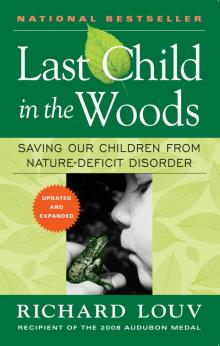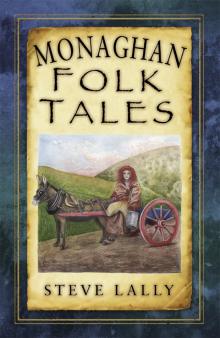Last Child in the Woods: Saving Our Children From Nature-Deficit Disorder


Author: Louv, Richard
Category: Other2
Published: 2005
Series:
View: 301
Read Online"I like to play indoors better 'cause that's where all the electrical outlets are," reports a fourth-grader. Never before in history have children been so plugged in—and so out of touch with the natural world. In this groundbreaking new work, child advocacy expert Richard Louv directly links the lack of nature in the lives of today's wired generation—he calls it nature deficit—to some of the most disturbing childhood trends, such as rises in obesity, Attention Deficit Disorder (ADD), and depression.Some startling facts: By the 1990s the radius around the home where children were allowed to roam on their own had shrunk to a ninth of what it had been in 1970. Today, average eight-year-olds are better able to identify cartoon characters than native species, such as beetles and oak trees, in their own community. The rate at which doctors prescribe antidepressants to children has doubled in the last five years, and recent studies show that too much computer use spells trouble for the developing mind.Nature-deficit disorder is not a medical condition; it is a description of the human costs of alienation from nature. This alienation damages children and shapes adults, families, and communities. There are solutions, though, and they're right in our own backyards. Last child in the Woods is the first book to bring together cutting-edge research showing that direct exposure to nature is essential for healthy childhood development—physical, emotional, and spiritual. What's more, nature is a potent therapy for depression, obesity, and ADD. Environment-based education dramatically improves standardized test scores and grade point averages and develops skills in problem solving, critical thinking, and decision making. Even creativity is stimulated by childhood experiences in nature. Yet sending kids outside to play is increasingly difficult. Computers, television, and video games compete for their time, of course, but it's also our fears of traffic, strangers, even virus-carrying mosquitoes—fears the media exploit—that keep children indoors. Meanwhile, schools assign more and more homework, and there is less and less access to natural areas.Parents have the power to ensure that their daughter or son will not be the "last child in the woods," and this book is the first step toward that nature-child reunion.From Publishers WeeklyToday's kids are increasingly disconnected from the natural world, says child advocacy expert Louv (Childhood's Future; Fatherlove; etc.), even as research shows that "thoughtful exposure of youngsters to nature can... be a powerful form of therapy for attention-deficit disorder and other maladies." Instead of passing summer months hiking, swimming and telling stories around the campfire, children these days are more likely to attend computer camps or weight-loss camps: as a result, Louv says, they've come to think of nature as more of an abstraction than a reality. Indeed, a 2002 British study reported that eight-year-olds could identify Pokémon characters far more easily than they could name "otter, beetle, and oak tree." Gathering thoughts from parents, teachers, researchers, environmentalists and other concerned parties, Louv argues for a return to an awareness of and appreciation for the natural world. Not only can nature teach kids science and nurture their creativity, he says, nature needs its children: where else will its future stewards come from? Louv's book is a call to action, full of warnings—but also full of ideas for change. Agent, James Levine. (May 20) Copyright © Reed Business Information, a division of Reed Elsevier Inc. All rights reserved. From Scientific AmericanUnstructured outdoor play was standard for me as a hyperactive child growing up in the rural Midwest. I fondly recall digging forts, climbing trees and catching frogs without concern for kidnappers or West Nile virus. According to newspaper columnist and child advocate Richard Louv, such carefree days are gone for America’s youth. Boys and girls now live a "denatured childhood," Louv writes in Last Child in the Woods. He cites multiple causes for why children spend less time outdoors and why they have less access to nature: our growing addiction to electronic media, the relinquishment of green spaces to development, parents’ exaggerated fears of natural and human predators, and the threat of lawsuits and vandalism that has prompted community officials to forbid access to their land. Drawing on personal experience and the perspectives of urban planners, educators, naturalists and psychologists, Louv links children’s alienation from nature to attention-deficit hyperactivity disorder, stress, depression and anxiety disorders, not to mention childhood obesity. The connections seem tenuous at times, but it is hard not to agree with him based on the acres of anecdotal evidence that he presents. According to Louv, the replacement of open meadows, woods and wetlands by manicured lawns, golf courses and housing developments has led children away from the natural world. What little time they spend outside is on designer playgrounds or fenced yards and is structured, safe and isolating. Such antiseptic spaces provide little opportunity for exploration, imagination or peaceful contemplation. Louv’s idea is not new. Theodore Roosevelt saw a prophylactic dose of nature as a counter to mounting urban malaise in the early 20th century, and others since have expanded on the theme. What Louv adds is a focus on the restorative qualities of nature for children. He recommends that we reacquaint our children and ourselves with nature through hiking, fishing, bird-watching and disorganized, creative play. By doing so, he argues, we may lessen the frequency and severity of emotional and mental ailments and come to recognize the importance of preserving nature. At times Louv seems to conflate physical activity (a game of freeze tag) with nature play (building a tree fort), and it is hard to know which benefits children most. This confusion may be caused by a deficiency in our larger understanding of the role nature plays in a child’s development. At Louv’s prompting, perhaps we will see further inquiry into this matter. In the meantime, parents, educators, therapists and city officials can benefit from taking seriously Louv’s call for a "nature-child reunion." Jeanne Hamming
 Tin Men: A Gripping Chrissy Livingstone Novel
Tin Men: A Gripping Chrissy Livingstone Novel Walk of the Spirits
Walk of the Spirits The Hitchhike
The Hitchhike Monaghan Folk Tales
Monaghan Folk Tales The Unsound Sister
The Unsound Sister Fearless to Love
Fearless to Love Black Tie Billionaire
Black Tie Billionaire Daddy's Pet (Lost Coast Daddies Romance Book 5)
Daddy's Pet (Lost Coast Daddies Romance Book 5)